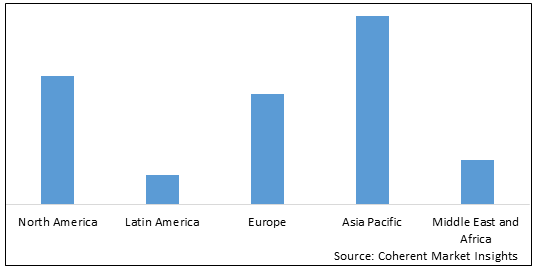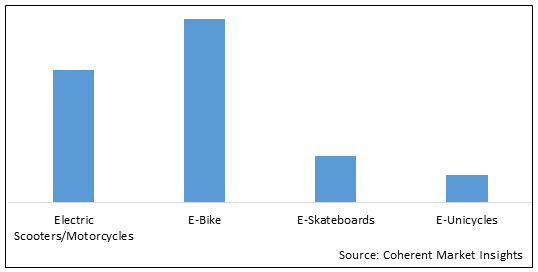Micro-mobility Charging Infrastructure Market is estimated to be valued at USD 7,503.4 Mn in 2025 and is expected to reach USD 27,792.8 Mn in 2032, exhibiting a compound annual growth rate (CAGR) of 20.6% from 2025 to 2032. Growing population is indirectly leading to the depletion of ozone layer, which then leads to increased greenhouse effect, and this has compelled several countries to take measures to minimize the greenhouse effect by adopting vehicles using alternative sources of energy such as e-scooters, e-bicycles, and so on. This has led the key players in the market to install charging points for micro-mobility vehicles. For instance, in March 2021, Duckt, a developer of universal micro-mobility infrastructure solution, introduced 150 dock, lock, and charge points across the Paris Rive Gauche area in France. The main objective was to promote the use of electric vehicles by introducing charging stations.
Global Micro-mobility Charging Infrastructure Market: Regional Insights
Among regions, Asia Pacific held a dominant position in the global micro-mobility charging infrastructure market in 2025, and is estimated to retain its dominance throughout the forecast period, owing to high demand for energy-efficient and emission-free electric two-wheelers, thus making charging infrastructure a necessity for increasing two wheeler vehicle sales in the region. For instance, in April 2021, Ola Electric, a subsidiary of Ola Mobility set up 100 thousand charging stations across 400 cities. The company’s charging stations will be deployed as stand-alone towers in popular locations including malls, IT parks, and so on. Therefore, these factors are expected to boost the growth of the global micro-mobility charging infrastructure market.
Furthermore, increasing consumer demand for e-scooters and e-bikes across the U.S. and Europe is expected to boost the global micro-mobility charging infrastructure market growth. For instance, in September 2021, the Government of Sweden signed a purchase agreement with CityBike Global, an electric bike manufacturer, for approximately 5,100 units of electric bikes. Through this, the government planned to roll out a municipal bike sharing service across Stockholm.
Figure 1: Global Micro-mobility Charging Infrastructure Market Share (%), By Region, 2025

To learn more about this report, Request sample copy
Global Micro-mobility Charging Infrastructure Market: COVID-19 Impact
The outbreak of COVID-19 is expected to negatively influence the global micro-mobility charging infrastructure market growth. Initially in the pandemic, few companies witnessed decreased sales of e-scooters and e-bikes as the global supply chain was disrupted by lockdown orders and bike stores were forced to close. This has impacted the profitability of the companies. Also, a lack of strong policy framework and public awareness is further anticipated to hamper the market growth over the forecast period.
Global Micro-mobility Charging Infrastructure Market Drivers:
Increasing awareness to reduce greenhouse gas emissions
Micro mobility solutions such as electric scooters, e-bikes and other lightweight vehicles have emerged as an increasingly popular mode of transportation in many urban areas around the world. The adoption of these vehicles contribute to the reduced traffic congestion and improved air quality. In addition, the economic benefits offered by the micro mobility along with rising adoption as a means of transportation are expected to propel the demand for charging infrastructure across geographies.
Micro-mobility Charging Infrastructure Report Coverage
| Report Coverage | Details | ||
|---|---|---|---|
| Base Year: | 2024 | Market Size in 2025: | USD 7,503.4 Mn |
| Historical Data for: | 2020 To 2024 | Forecast Period: | 2025 To 2032 |
| Forecast Period 2025 to 2032 CAGR: | 20.6% | 2032 Value Projection: | USD 27,792.8 Mn |
| Geographies covered: |
|
||
| Segments covered: |
|
||
| Companies covered: |
Ather Energy, bike-energy, Bikeep, Flower Turbines, Get Charged, Inc., Giulio Barbieri SRL, Ground Control Systems, Magment GmbH, Perch Mobility, Robert Bosch GmbH, Solum PV, SWIFTMILE, and the Mobility House GmbH |
||
| Growth Drivers: |
|
||
| Restraints & Challenges: |
|
||
Uncover macros and micros vetted on 75+ parameters: Get instant access to report
Global Micro-mobility Charging Infrastructure Market Opportunities:
Many government agencies around the world are offering incentives for the adoption of micro mobility vehicles, including subsidies for the purchase of electric scooters and bikes. For instance, in April 2021, the French government along with the French Federation planned to offer an incentive program to enable individuals buy electric bikes. Under this scheme, the authorities will offer approximately US$ 2,675 to electric bike consumers. Through this, the government agencies are propelling the uptake of electric bikes in France. Additionally, the regulatory authorities are also offering funding for the development of charging infrastructure. This is anticipated to create an opportunity for the company in the micro-mobility charging infrastructure market to collaborate with regulatory bodies to expand their operations and support the business reach across unserved regions.
Global Micro-mobility Charging Infrastructure Market Trends:
Expansion of charging networks is one of the major trends
As the demand for micro-mobility vehicles is rapidly increasing, there is a need for large charging infrastructure to support these vehicles. This has led to an expansion of charging infrastructure, with the companies investing in new charging stations and partnering with other organizations to increase their reach.
Global Micro-mobility Charging Infrastructure Market Restraints:
Low level of awareness about shared mobility across the emerging economies to impede market pace
Shared mobility services such as bike sharing and scooter sharing are still relatively new concepts in many emerging economies. This has resulted in lack of understanding about these services; further restraining micro-mobility charging infrastructure provider companies in generating demand for their services. Furthermore, there are limited regulations and policies in place to support the growth of shared mobility services. These circumstances are resulting in challenges for the companies to operate across these developing economies. This is anticipated to restrict the companies offering micro-mobility charging infrastructure to enter in these regions.
Figure 2: Global Micro-mobility Charging Infrastructure Market Share (%), By Vehicle Type, 2025

To learn more about this report, Request sample copy
Global Micro-mobility Charging Infrastructure Market Segmentation:
The global micro-mobility charging infrastructure market report is segmented into Vehicle Type, Type, Source, and End Use. Among vehicle type segment, e-bike segment held the highest market share in the year 2025, and is expected to retain its market share over the forecast period. The consistent technological advancements in electric bike are expected to contribute to the adoption across geographies. For instance, in
increase in sales and adoption of e-bike is expected to boost the global micro-mobility charging infrastructure market over the forecast period. For instance, in September 2021, in Horizon 2020 Lighthouse Project REPLICATE project, advanced telematics equipment were integrated with the fleet of electric bikes. The telematics equipment is powered by the bike’s electric system and collects user behavior data through internal connection
Global Micro-mobility Charging Infrastructure Market: Key Developments
For instance, in February 2022, Dott, a Europe-based electric bike manufacturing company, raised approximately US$ 75 million from series B funding round. The company has planned to invest the raised funding for new product developments and fuel the business output.
In November 2021, TIER, a micro-mobility company in Europe, launched over 500 units of electric bikes in Islington, U.K. Through this, the company expanded its portfolio of green transport solutions across the city.
In May 2021, Helbiz, a micro-mobility company, announced a partnership with Be Charge, which is a S.p.A. group company. The partnership aims for the deployment of charging infrastructures to enhance electric mobility in Italy. Furthermore, it will offer innovative scooter sharing services across Rimini, Italy accompanied by Be Charge's extensive charging network.
In September 2020, Sparta, an Accell Group company, launched d-Burst, its new range of pedal assisted electric bikes catering to consumers preferring electric bikes to travel between workplace and home. This launch helped the company expand its electric bike portfolio and address the demand from customers
Global Micro-mobility Charging Infrastructure Market: Key Companies Insights
Major companies operating in the global micro-mobility charging infrastructure market include Ather Energy, bike-energy, Bikeep, Flower Turbines, Get Charged, Inc., Giulio Barbieri SRL, Ground Control Systems, Magment GmbH, Perch Mobility, Robert Bosch GmbH, Solum PV, SWIFTMILE, and the Mobility House GmbH.
*Definition: The micro-mobility charging infrastructure can refer to docking stations, ramps, and others. These charging infrastructure can be deployed in residential sites or commercial sites. Moreover, several micro-mobility vehicles such as electric bike and electric scooters (depending on the model) can be charged at the same time at the micro-mobility charging station.
Share
Share
About Author
Gautam Mahajan is a Research Consultant with 5+ years of experience in market research and consulting. He excels in analyzing market engineering, market trends, competitive landscapes, and technological developments. He specializes in both primary and secondary research, as well as strategic consulting across diverse sectors.
Missing comfort of reading report in your local language? Find your preferred language :
Transform your Strategy with Exclusive Trending Reports :
Frequently Asked Questions
Select a License Type
Credibility and Certifications

860519526

9001:2015
27001:2022


Joining thousands of companies around the world committed to making the Excellent Business Solutions.
View All Our Clients
US Reciprocal Tax Impact Analysis On Micro-mobility Charging Infrastructure Market
Stay updated on tariff changes with expert insights and timely information